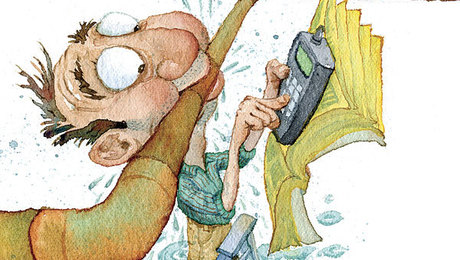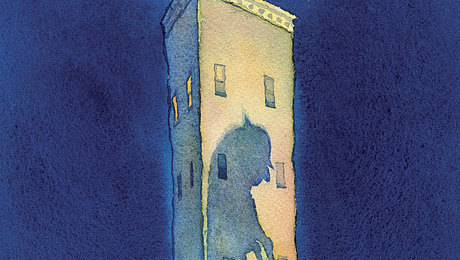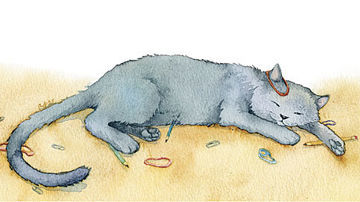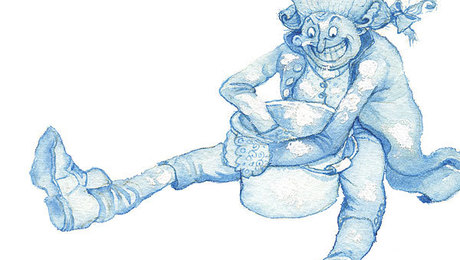El Rancho Encantado
Great moments in building history: The small scale American dream
I was at the University Theater in Berkeley, California, when I decided to build a scale model of a mobile home. I was viewing Werner Herzog’s Strozek, a film about a zany troupe from Berlin who make their way to Railroad Flats, Wisconsin. There, while visiting long-lost relatives, they discover the joys of mobile homesteading, animal magnetism and waitressing at a truck stop. As the long winter wears on, however, angst-inducing forces unleashed on the once-merry troupe culminate in the repossession of their trailer. In one stroke they lose what Americans prize most—unfettered mobility and the American dream of homeownership, as symbolized by the mobile home.
I left the theater filled with ideas of how to construct a model mobile home. Sipping coffee on Telegraph Ave., I worked out the basics on the back of a napkin. Then I began collecting materials.
Exterior detailing—A couple of years and 1,000 miles later in New Mexico, my neighbor came upon a miniature Blessed Virgin Mary while working in her yard. We called her the Milagro (Miracle). The Milagro turned out to be the missing ingredient, and because work was slow, I decided it was time to build the trailer. It came to be known as El Rancho Encantado (the enchanted ranch).
The trailer sits on a base of buckskin-colored stucco. Its walls are fashioned out of 1⁄4-in. plywood, which I routed to contain the 12v electrical lines. Hobby-shop shiplap clads the sides. The roof, which is held down with little tires, is topped with a swamp cooler.
The running lights work—ready for that blast down the highways of America—as do the interior lights and a bare-bulb bug light at the porch. Last but not least is the mercury-vapor halogen yard light—the kiss of death of rural America. The ghoulish light is fashioned from a minispotlight, which I sheathed in a bluish cellophane to replicate the ghastly light from the real thing.
The Blessed Virgin Mary is hand-painted and ensconced in her bathtub grotto (from a hobby supply—true porcelain). A mini grain-of-wheat bulb illuminates her in her tub-and-rock shelter.
Finishing the interior—Under the removable roof, the rooms are divided by partitions. I laid linoleum in the kitchen and the bath. The linoleum is buckled a little at the threshold to reflect some wear and tear. The living area and the bedroom are carpeted with shag rugs made from velour scraps. I sanded the velour threadbare in the traffic ways, then covered it with a strip of clear vinyl to duplicate a carpet runner. The walls in the living room, the hallway and the bedroom are dark-stained basswood because its tight grain is in scale. The walls in the kitchen and the bathroom are fake-brick wallpaper.
The shack addition was built just like the real thing: cobbled together from studs (balsa), pumice block (balsa) covered with builder’s felt (black construction paper). The Astroturf covering the steps is green, slightly fuzzy Christmas gift-wrap tape. A storage shed on the backside of the trailer houses the transformers, the fuses and the switches for the trailer’s electrical system.
Chevy as storage locker—A ’57 Chevy Nomad awaits repair in the rutted driveway. I chose a station wagon for a variety of reasons, the main one being that it would fool the eye and look a bit larger than it really is. The scale model of the trailer is 1:12, the car is 1:16, so with a station-wagon model and the hood and the doors propped open, it looks the right size.
A flip of the switch turns on the wagon’s single headlight and its twin tail lamps. With its front end held aloft on blocks, the headlight’s raised trajectory illuminates the heavens with a single, lonely beam. The doors, the hood and the roof are all dented (plastic slightly heated with a propane torch, then distorted), the right front fender is primered, and the rest of the wagon’s finish is sun-baked and faded. A coat hanger wired to the antenna’s stub searches the sky for radio signals. A dome light showcases the car’s finely detailed interior.
Besides languishing forlornly in the yard, the wagon’s ancillary purpose is golden: a storage locker. Filled with stuff too important to keep outside, the vehicle has become the repository of newspapers, fishing poles, tires, tools, books, maps, old lamps, you name it. And yes, the upholstery’s stuffing is coming out. There is a plastic Jesus on the dashboard. The dome light helps illuminate such things.
At the Smithsonian—This project took about 12 days to complete, from start to finish. Most of the tough work of collecting all the materials, however, had been accomplished prior to assembly.
The Rancho is now in the Smithsonian Institution. It awaits display in the museum’s still-to-come exhibit on life in the 20th century: The Hall of Everyday life in the American Past.
I hope they put it in a darkened room because the best time for viewing El Rancho Encantado is at night, with a few of its lights on. If you listen closely, you can almost hear the wind blow.
—James A. Burgel, a finish carpenter living in Santa Fe, N. M.
Fine Homebuilding Recommended Products
Fine Homebuilding receives a commission for items purchased through links on this site, including Amazon Associates and other affiliate advertising programs.

8067 All-Weather Flashing Tape

Handy Heat Gun

Reliable Crimp Connectors


























